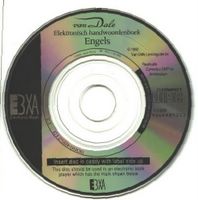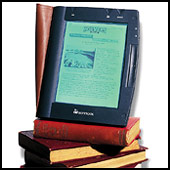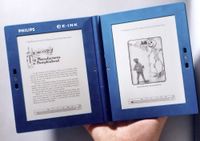
The Sony Datadiscman with an eBook (collection Jak Boumans)
Online had the promise of electronic publishing, in the end the compact disc technology appeared to be more concrete. The CD-ROM was a mega book. But it was Sony which hijacked the concept of Electronic Book and announced the electronic book in 1986, when CEO Akito Morita held up a disc in Mexico during a publishers’ meeting. By 1991 the concept had been realised as a Data Disc man with a mini-disc. The product was not a success despite the 350 titles. It was a a mismatch of technology and marketing (40 characters per line instead of 80 – reminding of the videotext vs ASCII battle; 450 gram for the Data Disc man and 1200 Dutch guilders or 550 euro). The Electronic Book was introduced in the Netherlands in 1993 by Sony and the Netherlands Electronic Book Committee (NEBC) and was disbandoned by 1995.


Three of the first Dutch e-Book titles (collection of Jak Boumans)
With the introduction of Internet, the online electronic book got attention. The Gutenberg project finally found an outlet. It had been started in 1971, when Mr Hart received computer time from Xerox as in gratitude for his services. He used the computer time to digitise and store classical books. But there were also new books which were published on Internet. In the Netherlands in 1993 Mr Marcel Bullinga was most likely the first author to use the Internet to distribute his novel Roes der zinnen (Flush of senses); the Dutch weekly De Groene characterised the novel as a “real monstrosity’.

Disc version of the first Internet book by Marcel Bullinga, signed by the author (collection Jak Boumans)
But Internet would play a larger role in the second wave of electronic book. This time the technology was based on a reader, which could hold a number of books; the electronic book was a file in a particular format. The e-book files were distributed through Internet and could be downloaded on the PC and from there on the reader. Over against the disc books the online e-book offered more opportunities as to download parts of the book as promotion or downloading the e-book for a particular period and price. A promising start was made when the famous writer Stephan King started to sell his novel Riding the Bullet by chapter; yet the readers appeared not willing to pay. In the Netherlands New E-Publishing started an e-book production company in 2000 with the imprint ebook.nl, offering an assortment of 20.000 titles by now.


A single function Rocket book reader (left) and a multi-functional PDA (left)
E-book is a slowly developing business. There are questions about the single and multi-functionality (a special reader or a Personal Digital Assistant with agenda, telephone etc,) and the file format (PDF or a specific format). Recently a technical break-through appeared. Philips in co-operation with the American company E-Ink developed digital paper, a screen with black and white features comparable to paper (see Long version (2.26 min.). Yet the success of e-books will depend on the business proposals of the publishers as to the format, the price and the marketing.

Digital paper by Philips in co-operation with E-Ink (compliments Philips)

No comments:
Post a Comment